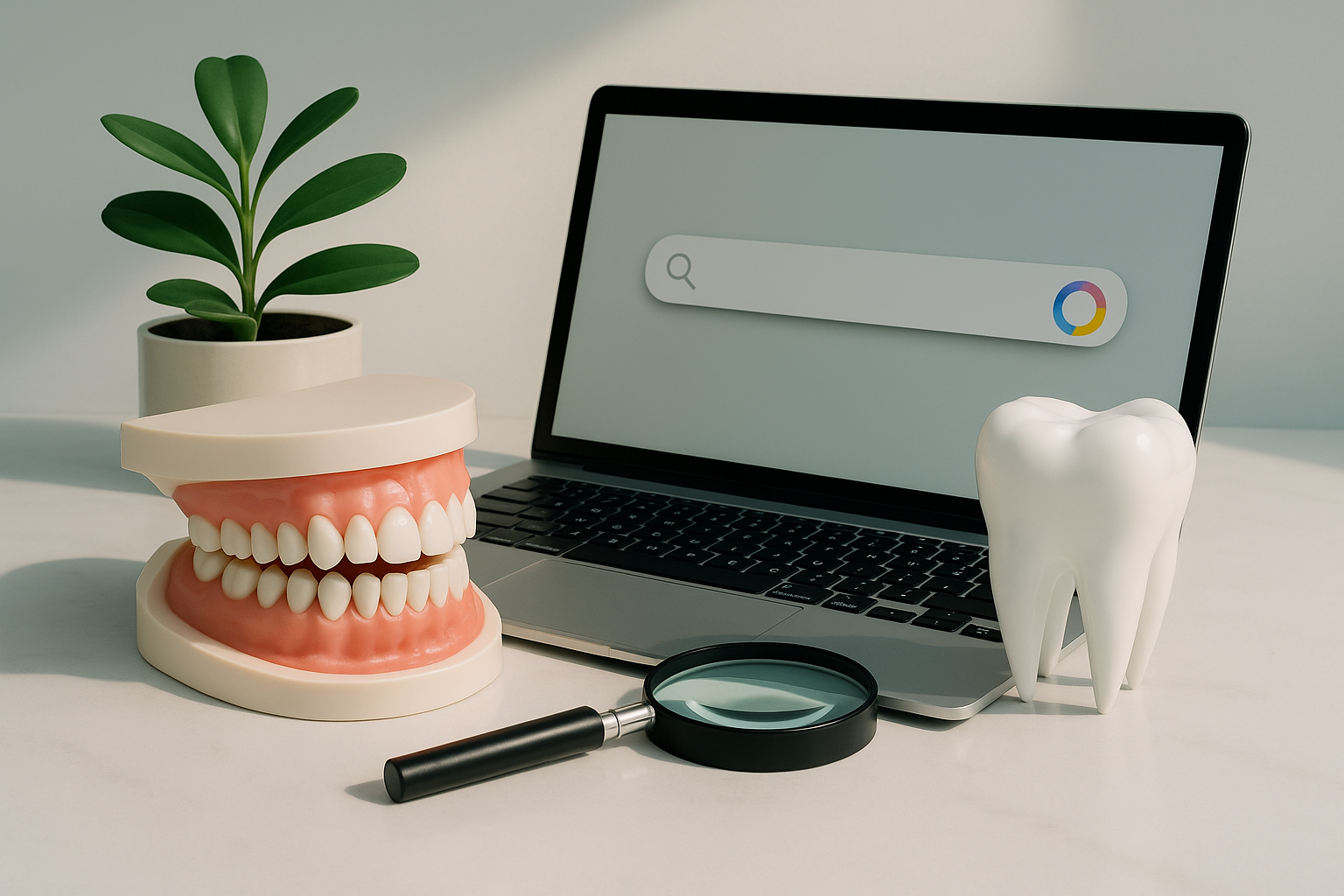Mastering Google My Business for Dental Practices: A Comprehensive Guide
In today's digital-first world, when a potential patient needs a dentist, their first instinct is almost always to search online. And for local searches, Google My Business (GMB) is not just important—it's absolutely critical. Your GMB profile is often the very first impression a prospective patient has of your practice, appearing prominently in Google Search results, Google Maps, and even influencing voice search queries. A well-optimized GMB listing can be the difference between a new patient walking through your doors and them choosing a competitor.
At Digital Floss, we understand that mastering GMB is foundational to local SEO success for dental practices. It's more than just claiming your listing; it's about strategically optimizing every element to ensure maximum visibility, attract qualified leads, and build trust with your local community. This comprehensive guide will walk you through the essential steps to not only set up but truly master your Google My Business profile, transforming it into a powerful patient acquisition tool for your dental practice.
Why Google My Business is Non-Negotiable for Dentists in 2025
In an increasingly localized and mobile-driven search environment, Google My Business (GMB) has evolved from a helpful tool into an absolute necessity for dental practices. It serves as your practice’s digital storefront, often providing the most immediate and impactful impression on potential patients. Here’s why a robust GMB profile is non-negotiable for your dental practice in 2025:
Dominance in Local Search Results:
- When someone searches for a "dentist near me" or "dental implants [your city]," Google prioritizes local businesses. Your GMB profile is the primary vehicle for appearing in the coveted "Local Pack" (the map results with 3 business listings) and Google Maps. These prominent placements receive a disproportionate share of clicks and calls.
- Example: A search for "pediatric dentist Miami" will almost certainly yield a Google Map with several GMB listings before organic website results.
First Impression and Trust Building:
- Your GMB profile provides a snapshot of your practice: address, phone number, website, hours, photos, and most importantly, patient reviews. This information is often the first point of contact for a potential patient. A complete, accurate, and visually appealing profile instills immediate trust and professionalism.
- Statistic: Studies show that businesses with complete GMB listings are 2.7 times more likely to be considered reputable by consumers [1].
Direct Patient Engagement:
- GMB allows patients to directly call your practice, get directions, visit your website, or even message you, all from within the search results. This frictionless path to engagement significantly increases conversion rates.
- Feature Highlight: The "Call" button on GMB listings is a direct conduit for new patient inquiries, especially for mobile users.
Influence on Voice Search:
- As discussed in our previous article on AI search, voice assistants like Siri and Google Assistant heavily rely on GMB data for local recommendations. If your GMB is not optimized, your practice simply won't be suggested for voice queries.
Scenario: "Hey Google, find a dentist open now near me." Google will pull information directly from GMB to provide a recommendation.
Patient Reviews and Reputation Management:
- GMB is the primary platform for Google reviews, which are arguably the most influential form of social proof for local businesses. A high volume of positive reviews and a strong average rating are critical for attracting new patients.
Impact: 88% of consumers trust online reviews as much as personal recommendations [2]. Your GMB reviews are front and center.
Insights and Analytics:
- GMB provides valuable insights into how patients are finding your listing, what actions they are taking (calls, website visits, direction requests), and where they are located. This data is invaluable for refining your marketing strategies.
Competitive Advantage:
- Many dental practices still underutilize their GMB profiles. By mastering yours, you gain a significant competitive edge, capturing patients who might otherwise go to a less visible competitor.
In essence, Google My Business is the cornerstone of your local digital presence. Neglecting it is akin to having a beautiful physical office but no sign out front. Digital Floss ensures your GMB profile is not just present, but powerfully optimized to attract and convert your ideal patients.
References:
[1] BrightLocal. (2023). Local Consumer Review Survey. https://www.brightlocal.com/research/local-consumer-review-survey/ [2] BrightLocal. (2023). Local Consumer Review Survey. https://www.brightlocal.com/research/local-consumer-review-survey/
Actionable Strategies for Optimizing Your GMB Profile: The Digital Floss Blueprint
Optimizing your Google My Business profile is an ongoing process that requires attention to detail and a strategic approach. At Digital Floss, we implement a comprehensive blueprint to ensure your dental practice’s GMB listing is not just complete, but truly optimized for maximum visibility and patient conversion. Here are the actionable strategies we employ:
Claim and Verify Your Listing:
- The First Step: If you haven’t already, claim your GMB listing. This typically involves a postcard verification process by mail to your physical practice address. This step is non-negotiable for managing and optimizing your profile.
- Accuracy is Key: Ensure your business name, address, phone number (NAP), and website URL are identical across all online platforms (your website, social media, directories). Inconsistencies can confuse Google and hurt your local ranking.
Complete All Profile Information Meticulously:
- Categories: Choose the most specific and relevant primary category (e.g., "Dentist" or "Dental Clinic") and add secondary categories that accurately describe your services (e.g., "Cosmetic Dentist," "Orthodontist"). This helps Google understand your practice’s offerings.
- Hours of Operation: Keep your regular and holiday hours updated. Patients often use GMB to check if you’re open.
- Services: Use the "Services" section to list all your key dental treatments. Be descriptive and include relevant keywords.
- Description: Write a compelling, keyword-rich description of your practice, highlighting your unique selling propositions and what sets you apart.
Upload High-Quality Photos and Videos:
- Visual Appeal: GMB profiles with photos receive more clicks and direction requests. Upload high-resolution photos of your exterior, interior (waiting room, treatment rooms), team members, and even patient smiles (with consent).
- Regular Updates: Continuously add new photos and videos to keep your profile fresh and engaging. This signals to Google that your practice is active and vibrant.
- Virtual Tour: Consider adding a 360-degree virtual tour to give potential patients a realistic sense of your office environment.
Actively Manage Patient Reviews:
- Encourage Reviews: Implement a system to consistently ask satisfied patients for reviews. This could be via email, SMS, or a simple in-office prompt. The more recent and positive reviews you have, the better.
- Respond to All Reviews: Respond promptly and professionally to every review, positive or negative. Thank positive reviewers and empathetically address negative feedback, offering solutions. This demonstrates excellent customer service and transparency.
- Keywords in Responses: Where natural, incorporate relevant keywords in your responses to reinforce your services and location.
Utilize GMB Posts:
- Regular Updates: GMB Posts are like mini-blog posts or social media updates directly on your profile. Use them to announce special offers, new services, team news, events, or share educational content. Posts stay live for 7 days (or longer for events/offers) and are a great way to keep your profile dynamic.
- Call-to-Action Buttons: Always include a call-to-action button (e.g., "Learn more," "Book," "Call now") to drive engagement.
Leverage the Q&A Section:
- Proactive Answering: Monitor the Q&A section where users can ask questions about your business. Proactively answer common questions yourself to control the narrative and provide accurate information. This also helps pre-empt patient inquiries.
Monitor Insights and Performance:
- Track Key Metrics: Regularly review your GMB Insights to understand how patients are finding your listing (direct search, discovery search), where they are viewing it (Search, Maps), and what actions they are taking (website clicks, calls, direction requests). Use this data to refine your strategy.
Link Building and Citations:
- While not directly within GMB, ensuring consistent NAP information across high-authority online directories and building local backlinks to your website reinforces your GMB profile’s authority in Google’s eyes.
By diligently implementing these strategies, Digital Floss transforms your Google My Business profile from a static listing into a powerful, dynamic marketing asset that actively attracts and converts new patients for your dental practice. It’s about creating a comprehensive local SEO ecosystem where your GMB profile is the central, thriving hub.
Conclusion: Your Path to Local Dominance with Digital Floss
In the highly competitive dental market, local visibility is paramount. Mastering your Google My Business profile is no longer an option; it’s a fundamental requirement for attracting and retaining patients in your community. A well-optimized GMB listing acts as your practice’s digital beacon, guiding prospective patients directly to your door through Google Search, Maps, and even voice commands.
Digital Floss specializes in transforming your GMB profile into a dynamic, patient-attracting powerhouse. We go beyond basic setup, implementing a comprehensive strategy that includes meticulous information completion, compelling visual content, proactive review management, and strategic use of GMB Posts. Our goal is to ensure your practice not only appears prominently in local search results but also converts those searches into valuable patient appointments.
Are you ready to dominate your local market and fill your appointment book with qualified patients? Don’t let your GMB profile be an afterthought. Contact Digital Floss today for a free marketing audit. Let us show you how a perfectly optimized Google My Business strategy can unlock unprecedented local growth for your dental practice.












